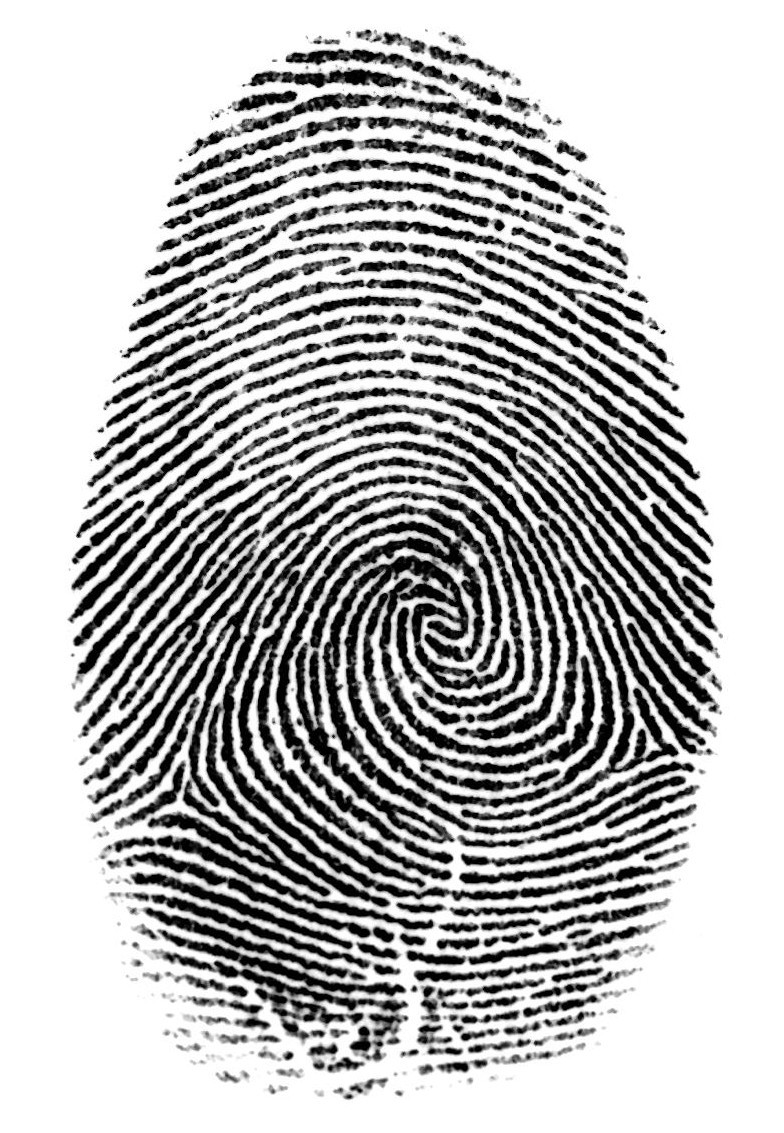The Fingerprint
 The unique nature of human fingerprints was among the many discoveries of
the great Czech physiologist and anatomist Johannes G.J. Purkinje
(1787-1869), whose name is associated with many structures. He
put forth his ideas on this subject in the mid 19th Century.
By the end of the 19th Century, Sir Arthur Conan Doyle's
fictional detective Sherlock Holmes was well acquainted with the
phenomenon (Doyle, a bored an unsuccessful physician, used his spare time to read the scientific literature and write the Holmes stories). It wasn't until the 20 Century that fingerprints were accepted as definitive proof identity in real police work, but they've been a tool of crime investigations ever since. Purkinje may not have realized what he was
starting, but he undoubtedly holds the world's record for Most
Criminals Convicted By An Anatomist's Ideas.
The unique nature of human fingerprints was among the many discoveries of
the great Czech physiologist and anatomist Johannes G.J. Purkinje
(1787-1869), whose name is associated with many structures. He
put forth his ideas on this subject in the mid 19th Century.
By the end of the 19th Century, Sir Arthur Conan Doyle's
fictional detective Sherlock Holmes was well acquainted with the
phenomenon (Doyle, a bored an unsuccessful physician, used his spare time to read the scientific literature and write the Holmes stories). It wasn't until the 20 Century that fingerprints were accepted as definitive proof identity in real police work, but they've been a tool of crime investigations ever since. Purkinje may not have realized what he was
starting, but he undoubtedly holds the world's record for Most
Criminals Convicted By An Anatomist's Ideas.
 A bit of literary trivia: Purkinje's discovery
earned him a spot in one of Mark Twain's novels, probably the only
anatomist to be so honored. The entire plot of Puddin'head Wilson, Twain's satirical commentary on the nature of Man and race prejudice, revolves around the identification of two individuals switched at birth, using their fingerprints.
A bit of literary trivia: Purkinje's discovery
earned him a spot in one of Mark Twain's novels, probably the only
anatomist to be so honored. The entire plot of Puddin'head Wilson, Twain's satirical commentary on the nature of Man and race prejudice, revolves around the identification of two individuals switched at birth, using their fingerprints.
The noseprints of dogs and many other species with hairless snouts are the result of the same forces that produce human fingerprints, and are as unique to individuals as are human fingerprints. They can be used for definitive identification of a specific animal in the same way.

Close This Window
 The unique nature of human fingerprints was among the many discoveries of
the great Czech physiologist and anatomist Johannes G.J. Purkinje
(1787-1869), whose name is associated with many structures. He
put forth his ideas on this subject in the mid 19th Century.
By the end of the 19th Century, Sir Arthur Conan Doyle's
fictional detective Sherlock Holmes was well acquainted with the
phenomenon (Doyle, a bored an unsuccessful physician, used his spare time to read the scientific literature and write the Holmes stories). It wasn't until the 20 Century that fingerprints were accepted as definitive proof identity in real police work, but they've been a tool of crime investigations ever since. Purkinje may not have realized what he was
starting, but he undoubtedly holds the world's record for Most
Criminals Convicted By An Anatomist's Ideas.
The unique nature of human fingerprints was among the many discoveries of
the great Czech physiologist and anatomist Johannes G.J. Purkinje
(1787-1869), whose name is associated with many structures. He
put forth his ideas on this subject in the mid 19th Century.
By the end of the 19th Century, Sir Arthur Conan Doyle's
fictional detective Sherlock Holmes was well acquainted with the
phenomenon (Doyle, a bored an unsuccessful physician, used his spare time to read the scientific literature and write the Holmes stories). It wasn't until the 20 Century that fingerprints were accepted as definitive proof identity in real police work, but they've been a tool of crime investigations ever since. Purkinje may not have realized what he was
starting, but he undoubtedly holds the world's record for Most
Criminals Convicted By An Anatomist's Ideas. A bit of literary trivia: Purkinje's discovery
earned him a spot in one of Mark Twain's novels, probably the only
anatomist to be so honored. The entire plot of Puddin'head Wilson, Twain's satirical commentary on the nature of Man and race prejudice, revolves around the identification of two individuals switched at birth, using their fingerprints.
A bit of literary trivia: Purkinje's discovery
earned him a spot in one of Mark Twain's novels, probably the only
anatomist to be so honored. The entire plot of Puddin'head Wilson, Twain's satirical commentary on the nature of Man and race prejudice, revolves around the identification of two individuals switched at birth, using their fingerprints.